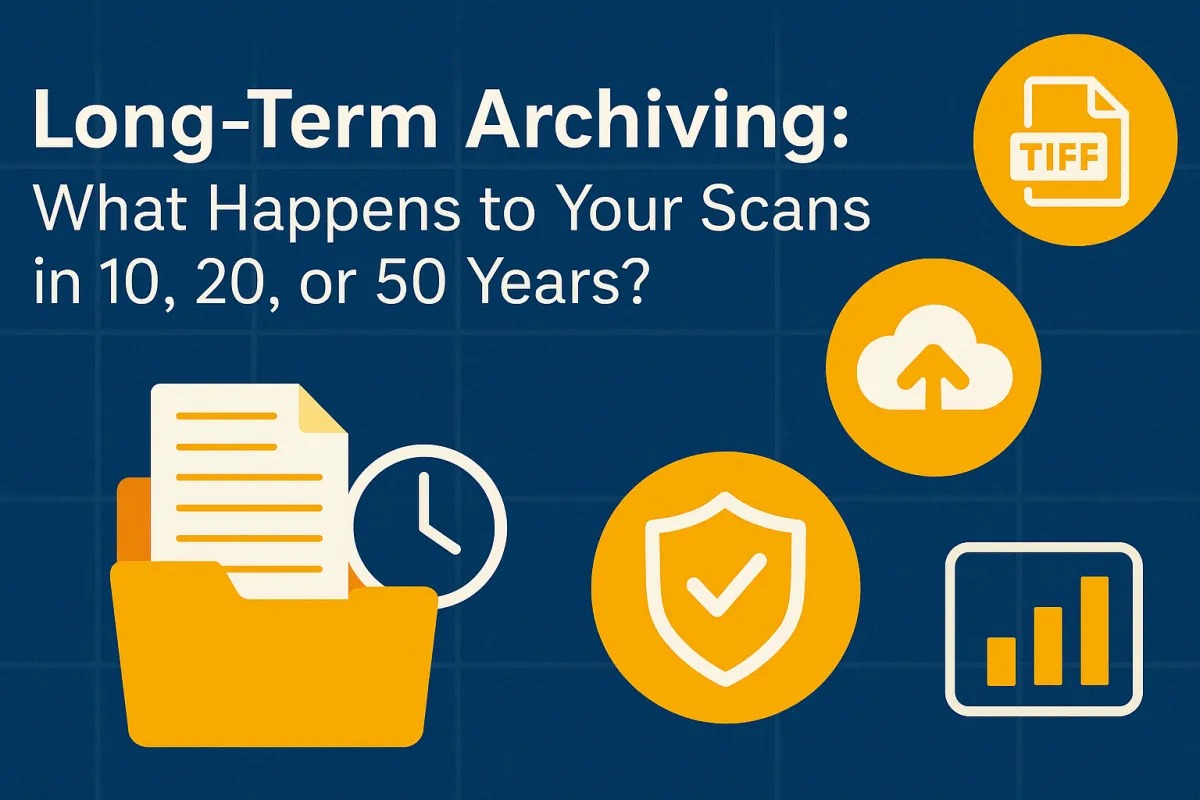
Long-Term Archiving: What Happens to Your Scans in 10, 20, or 50 Years?
By: USA IMAGING, Inc.
When organizations scan and digitize their documents, they often think in terms of immediate benefits: faster access, less paper, and improved workflows. But what about long-term archiving? What happens to those scanned files in 10, 20, or even 50 years?
The truth is, digital files are not automatically future-proof. Without proper planning, your scans could become unreadable, lost, or obsolete—negating the value of digitization.
Here’s how to ensure your scanned documents stand the test of time.
1. Choose Archival-Grade File Formats
Not all file formats are built for longevity. Some formats rely on proprietary software, while others may become unsupported over time.
Recommended archival formats:
TIFF (Tagged Image File Format)
Lossless and uncompressed
Excellent for preserving detail and document integrity
Ideal for legal, historical, and compliance-driven records
PDF/A (PDF for Archiving)
A standardized version of PDF meant for long-term archiving
Self-contained (fonts, color profiles, and images are embedded)
Preferred for text-based and multi-page documents
JPEG2000 or PNG
Suitable for color-rich or image-centric records, though less common in compliance-heavy industries
Avoid formats tied to specific apps or platforms that may not be supported in the future.
2. Store in Redundant and Durable Cloud Systems
Where you store your scans is just as important as how you save them.
Look for:
Geographically redundant backups (data stored in multiple locations)
Durable cloud platforms with 99.999999999% (11 nines) data durability
Encryption-at-rest and in-transit
Data integrity monitoring and automatic repair of corrupted files
Providers like Amazon S3 Glacier, Microsoft Azure Archive Storage, and Google Cloud Storage Nearline offer long-term, low-cost, high-durability solutions ideal for document archives.
3. Keep Metadata Intact
Metadata (such as document title, author, creation date, and keywords) adds long-term value by making files searchable and contextual. Make sure:
Metadata is stored within the file (e.g., embedded in PDF/A or TIFF tags)
Indexing systems are regularly updated and documented
You retain a master metadata export that’s platform-independent
This prevents records from becoming “digital orphans” with no searchable context.
4. Plan for Format Migration Over Time
Digital preservation is not a one-and-done task. To avoid file decay or obsolescence:
Establish a review schedule (e.g., every 5–10 years)
Stay informed about emerging formats and standards
Maintain flexibility to reprocess and migrate archives to newer formats as needed
Think of your archive as a living asset—one that needs upkeep to remain valuable over decades.
5. Document Your Storage and Retrieval Protocols
Make sure your future team can access today’s archive. That means:
Documenting folder structures, naming conventions, and indexing logic
Recording login credentials and access policies (and storing them securely)
Training staff on how to retrieve and maintain archives
Using non-proprietary software to ensure future readability
Institutional memory fades—documentation doesn’t.
Conclusion: Think Beyond Scanning. Think Preservation.
Scanning is only the first step. Without proper archiving strategy, those digital files could become as fragile as the paper they replaced.
By choosing durable formats, storing files redundantly, embedding metadata, and planning for future migrations, you can ensure your scanned documents remain accessible, compliant, and valuable for generations to come.
Need to future-proof your archives?
At USA Imaging, Inc., we specialize in long-term digital preservation strategies—from archival-grade scanning to secure cloud hosting. Let’s talk about your retention goals.
